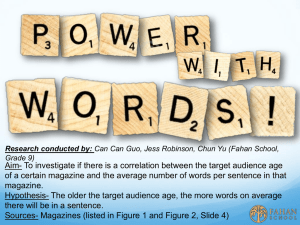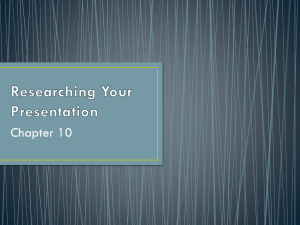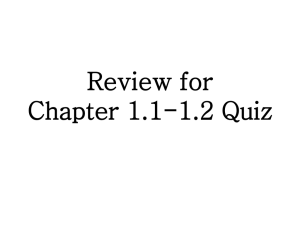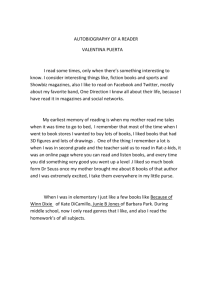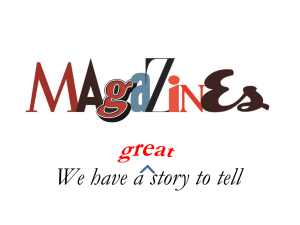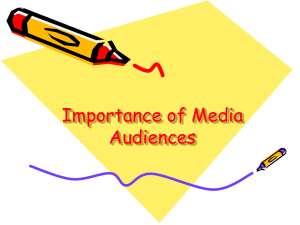Are magazines for young men likely to reinforce
advertisement
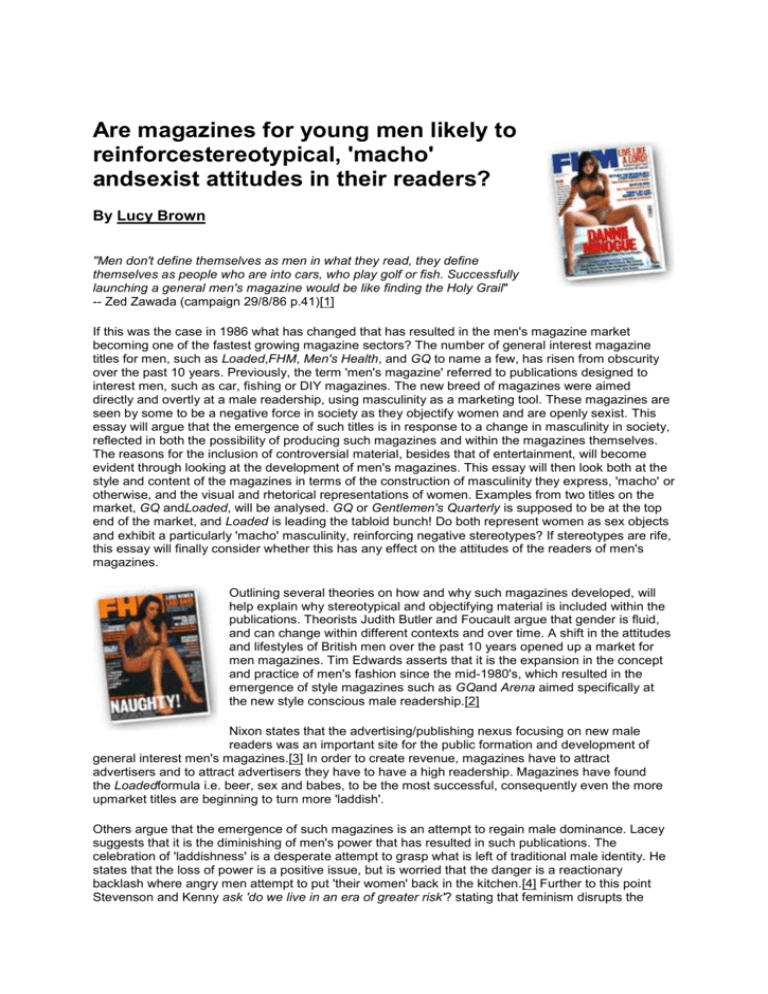
Are magazines for young men likely to reinforcestereotypical, 'macho' andsexist attitudes in their readers? By Lucy Brown "Men don't define themselves as men in what they read, they define themselves as people who are into cars, who play golf or fish. Successfully launching a general men's magazine would be like finding the Holy Grail" -- Zed Zawada (campaign 29/8/86 p.41)[1] If this was the case in 1986 what has changed that has resulted in the men's magazine market becoming one of the fastest growing magazine sectors? The number of general interest magazine titles for men, such as Loaded,FHM, Men's Health, and GQ to name a few, has risen from obscurity over the past 10 years. Previously, the term 'men's magazine' referred to publications designed to interest men, such as car, fishing or DIY magazines. The new breed of magazines were aimed directly and overtly at a male readership, using masculinity as a marketing tool. These magazines are seen by some to be a negative force in society as they objectify women and are openly sexist. This essay will argue that the emergence of such titles is in response to a change in masculinity in society, reflected in both the possibility of producing such magazines and within the magazines themselves. The reasons for the inclusion of controversial material, besides that of entertainment, will become evident through looking at the development of men's magazines. This essay will then look both at the style and content of the magazines in terms of the construction of masculinity they express, 'macho' or otherwise, and the visual and rhetorical representations of women. Examples from two titles on the market, GQ andLoaded, will be analysed. GQ or Gentlemen's Quarterly is supposed to be at the top end of the market, and Loaded is leading the tabloid bunch! Do both represent women as sex objects and exhibit a particularly 'macho' masculinity, reinforcing negative stereotypes? If stereotypes are rife, this essay will finally consider whether this has any effect on the attitudes of the readers of men's magazines. Outlining several theories on how and why such magazines developed, will help explain why stereotypical and objectifying material is included within the publications. Theorists Judith Butler and Foucault argue that gender is fluid, and can change within different contexts and over time. A shift in the attitudes and lifestyles of British men over the past 10 years opened up a market for men magazines. Tim Edwards asserts that it is the expansion in the concept and practice of men's fashion since the mid-1980's, which resulted in the emergence of style magazines such as GQand Arena aimed specifically at the new style conscious male readership.[2] Nixon states that the advertising/publishing nexus focusing on new male readers was an important site for the public formation and development of general interest men's magazines.[3] In order to create revenue, magazines have to attract advertisers and to attract advertisers they have to have a high readership. Magazines have found the Loadedformula i.e. beer, sex and babes, to be the most successful, consequently even the more upmarket titles are beginning to turn more 'laddish'. Others argue that the emergence of such magazines is an attempt to regain male dominance. Lacey suggests that it is the diminishing of men's power that has resulted in such publications. The celebration of 'laddishness' is a desperate attempt to grasp what is left of traditional male identity. He states that the loss of power is a positive issue, but is worried that the danger is a reactionary backlash where angry men attempt to put 'their women' back in the kitchen.[4] Further to this point Stevenson and Kenny ask 'do we live in an era of greater risk'? stating that feminism disrupts the certainties of the gender order. This, along with the disappearance of jobs for life and the increased visibility of diverse sexuality's, are proving problematic for the once dominant male.[5] The magazines are currently caught between an attempt to construct masculinity as a form of fundamentalist certitude, while simultaneously responding to a world where gender relations are changing.[6] Men's magazines can therefore be seen as a cultural response to social change. It has been argued that men's magazines are not solely responding to gender changes, but are a reaction to feminism and an attempt for men to regain some of the power they lost through this movement, in other words to return to a pre-feminist masculine ideal. As Stevenson puts it 'a 'blokelash' against feminism.'[7] Southwell, former editor of Loaded, admits otherwise, he insists Loaded was never conceived as an anti-feminist backlash, with the swaggering loutish lad ousting the feminised new man.[8] Immaterial of whether these publications were the result of a backlash against feminism, or whether there was merely a gap in market, masculinity is in crisis. Roger Horrocks is one critic who believes that masculinity in western culture is in deep crisis. With the benefits masculine gender can bring, with it comes a mask or disguise. The emphasis on male dominance in public areas of life has tended to obscure the emotional poverty of many men's lives.[9]Magazines tend to reflect this in that they portray only one side of masculinity, leaving out the emotional bit, and concentrating on the outward display of masculinity. Here one can see that the stereotyping of men within these magazines as macho male and ignoring the stereotypical 'emotional male' or even 'soft lad', can lead to problems and criticisms. Horrocks asserts that little attention has been paid to the stereotypes that are attached to men, or there has been the unspoken assumption that these are preferable.[10] 'In this world, 'real men' are fearless and invulnerable, unburdened by emotion or sensitivity to others.'[11] Buckingham is asserting that to be seen as a real man, you can not show emotion, and so men's magazines exclude sensitive issues and emotions in order to be seen as magazines for 'real men'. In discussing the release of a new magazine 'Deluxe' in an article for the media guardian, John Dugdale writes 'even though banning babes sacrifices the one sure-fire sales-boosting device in today's men's market, not least by reducing horny schoolboy appeal. Are there really 150,000 soft lads out there.'[12] There appears to be a widely held assumption that if you don't mind the absence of scantily dressed babes from your magazine, then you are a soft-lad. 'What is obviously missing from this celebration of one-night stands, obsessive consumerism and male bonding is how men's needs for reciprocity and emotional warmth are to be met.'[13] (Stevenson et al, 2000) Metcalf and Humphries in their 1985 book 'The sexuality of men' describe a masculinity that doesn't seem too far removed from what magazines are portraying today. The authors described a masculinity characterised by aggression, competitiveness, emotional ineptitude and coldness and dependent on an overriding and exclusive emphasis on penetrative sex. What also emerged was the side of masculinity that the magazines try to avoid, a sense of the fears, anxieties and pain expressed by these men in relation to established script of masculinity; anxieties about sexual performance, estrangement from emotions, and poor relations with fathers.[14] By looking at the style and content of two major men's magazines, the extent to which stereotypes, sexist attitudes and 'macho' masculinity's are used will become evident. Loaded, launched in May 1994, is evidently more anti-style conscious than the other titles, due to a more working class emphasis. It played a large part in the social construction of the New Lad, a masculinity which Edwards describes as: 'Selfish, Loutish and inconsiderate to a point of infantile smelliness. He likes drinking, football and fucking, and in that order of preference.......in short he is that most ghastly of all configuration, defensively working class which also means defensively masculine'.[15] (Edwards, 1997) GQ's catch phrase is 'the magazine for men with an IQ,' in which it takes pleasure in the more traditional masculinity, including coverage of executive concerns and pitching itself at a more serious minded conservative older reader than the other titles. At it's release GQ was organised around menswear and style, popular music was absent and the kind of figures interviewed or profiled in GQ tended to be traditional professionals rather than the media-fashion-art based individuals of other titles. Visualised representation of women were marginal. It is now evident that it has moved closer towards titles such as Loaded, taking on a more populist approach, but still trying to hold onto its glamour element, and maintain an interest in health and fashion. Edwards believes the primary role of men's style magazines is to encourage and perpetuate spending amongst its readers, evident through the emphasis upon consumption as a means to join the new style elite, the high-profile advertising, and the visual attention paid to commodities. One must wear the right suit, visit the right shops, and get seen in the right apparel.[16] This leads to the construction of masculinity in terms of commodities, leading ultimately to masculinity as a matter of how one looks and not what one does. Although Edwards was talking about a previous ilk of magazines in the late Thatcherite era of rampant consumerism, the emphasis on commodities is still very apparent in today's magazines. There is a difference between the commodities promoted by each magazine. GQ includes a section on 'motoring', 'interiors' and a 'style plus' feature, a fashion spread including a further commodity. For example 'Tooled up' (April 2000) features the latest DIY tools. Figure 1 reveals two aspects of GQ, firstly their target market. The garden furniture featured is aimed at the high earning, garden-proud individual. Secondly the feature uses women to make it more appealing to the reader. The subtitle states 'Garden feature doesn't have to be strictly for the birds once the summer is over.' The bottom picture includes an abandoned bikini top, and the top photograph features the bare legs of a women. Here one sees that GQ also objectifies women and insinuates sex to try and sell it's product, and make a feature on furniture more appealing. Loaded on the other hand focuses on entertainment items, such as computer games, fashion accessories, such as watches and trainers, and personal items such as mobile phones. Figure 2 reveals the accoutrements of the Loadedman. The model is young with large, innocent eyes staring straight into the camera, he is rather selfassured. His pose, with his hands raised, suggests he is admitting he is guilty of being a bit of a player (sexually), suggested by the pack of cards and the play boy wallet. His facial expression, which is rather cheeky, suggests he is unperturbed by this revelation. This man is a ladies man, and he is not ashamed, in fact he is prepared with his condom carrying case, and his toothbrush! Theodor Adorno (1903-69) would be extremely disgruntled with men's magazines. Firstly, he would suggest that it is the culture industries that churn out these unsophisticated magazines, replacing the more critical art forms which might lead people to actually question social life. Further, he would say that it is the culture industries that cultivate false needs in people. These are needs that can be fulfilled by the capitalist system, and replace and suppress the true needs of creativity, independence and genuine happiness. Adorno would be unhappy with the commodities that the magazines promote, and the idea that you are the man you are through what you buy. Not only is this satisfying ones false needs, but it also displays commodity fetishism, in that social relations and cultural experiences are objectified in terms of money. The readers are delighted by products because of how much they cost.[17] Sexism is an infamous trait of men's magazines, and it is believed that this will inevitably produce sexist attitudes amongst the readers. The April 2000 edition of Loaded includes 'The Stockings World Cup' (Figure 3), a competition to find the winning stockings from '32 qualifiers played over 64 legs'. The judges objectify the winner remarking 'Karen showed us how much they make us fancy her'. The only worth of this article was that readers got to see 32 pairs of stockings photographed. Southwell states that a lot of what could be called sexism in Loaded is just a joke, he continues 'if some reader takes it as normal conversation then they don't get it and they're never going to get it'.[18] But isn't this the problem? Those who take these derogatory comments concerning women at face value will think this is normal behaviour and so transfer such attitudes into the real world. Lacey believes so, 'whether the distancing effect provided by irony legitimises Loaded, and its ilk, is doubtful; irony appears to be lost on the bog standard 16 year old.'[19] Peter Howorth, the previous editor of Esquire attempts to justifies the objectification of women by saying 'Any good magazine must offer a balance of content, and part of that balance, if it is to reflect the interests of men, will inevitable be articles on beautiful women'.[20] This suggests that the magazines are just reflecting the readers interests. Feminists have argued that whatever the psychology of the men who rape, the background to its prevalence must be located in societies which define 'masculinity' at least in part, in terms of the assertion of heterosexual power, and which continue to produce images across all forms of representation depicting women as the prototypical object of sexual desire, men as its prototypical subjects.[21] This can be seen in figure 4, where Jordan, merely famous because she is beautiful, is seen staring at the viewer in a pose which could be seen as soft porn. Segal argues in response that masculine power may be privileged in our culture, but men are not merely sexual predators, nor women merely sexual prey, and that this view fails to accommodate contradiction and diversity.[22] A further characteristic evident through the style and content of both magazines, and all men's magazines in general, is that they assert the heterosexuality of their readers. Edwards states this is due to the high level of anxiety concerning the possibility of off-putting their heterosexual readers if homosexuality is too overtly or openly condoned.[23] The magazines stress the virtues of a single lifestyle, as Stevenson et al state 'The great prize of bachelor hood is represented as a life where one has little responsibility for others and where one is truly free to do as one chooses, further, marriage is viewed as a form of social constraint, preventing men in their early 30's from living a life of consumption and sexual freedom.'[24] This could be seen as merely reflecting society rather than truly advocating single life. Whereas Edwards sites consumption as the major site of masculinity's in magazines, Sean Nixon believes that it is within the fashion photography that the new coding's of masculinity, and there is more than one, are most extensively elaborated.[25] Menswear is seen primarily in terms of utility. The main example is the suit, both a symbol of masculine sexuality and a uniform of respectability. GQ focus quite strongly on the suit within its fashion pages. Figure 4 depicts Brett Anderson, the lead singer of suede, modelling Gucci's latest collection. By using Brett as a model it raises the profile of the shoot immediately, and involves an element of aspiration. In this photograph Anderson is situated in a large, panelled room. Many signifiers within the picture go against the 'macho' male mould. Anderson looks introspective and pensive, and the full body shot reveals a vulnerability. Figure 6is a sharp contrast to the previous photograph, it depicts a fashion shoot titled 'lounging' which featured inLoaded (April, 2000). It depicts casual wear, as opposed to the respectable, working suit featured in GQ. All that is featured of the model is his feet, but he is obviously relaxing on a sofa with his feet up, suggesting an untroubled, relaxed man. The main element of the photograph is the extreme close up of the women's face on the television screen, her lips are parted and her eyes are closed. It is a very sexual face, again highlighting the fact that women are used throughout the magazine, even within fashion shoots, as objects for men to look at, and highlighting the laddish masculinity of the male. Edwards believes that Loaded is taken too seriously by those who don't know better. But does the content ofLoaded effect its readers? Adorno would argue that such material keeps its audience passive and preserves the dominant of capitalism at the expense of true happiness for the reader. Foucault, would structure his argument around power. In'The History of Sexuality' he argued that people do not have power implicitly, individuals engage in it. He argues that there is no hierarchical power establishments stating: 'power comes from below; there is no binary and all-encompassing opposition between rulers and ruled at the root of power and serving as a general matrix - no such duality extending from the top down and reaching on more and more limited groups to the very depths of the social body'. [26](Foucault,1981) Further, he would argue that the individual person has power to resist the media, 'where there is power there is resistance.'[27] This rejects the elitist view of the Frankfurt school, who believed the culture industry had an effect of anti-enlightenment, Adorno asserts 'it impedes the development of autonomous, independent individuals who judge and decide consciously for themselves.'[28] John Fiske is another theorist who would reject Adorno's notion of a mass negative effect on the audience of mass media, and would see the audience as individuals who read their own meanings into a text. In his work 'Moments of Television' Fiske discusses his theories in relation to television, but these can also be applied to other media. 'Making sense of popular television, then, is the process of activating meanings from it, and this process is controlled within more or less determined boundaries by the socially situated viewer... adequate space for different people to make different meaning'.[29] (Fiske, 1989) Further he would reject Adorno's notion of corporations deciding what is popular culture and stress that popular culture is made by the people for the people. 'It cannot conceive of the text as a site of struggle for the power to make meanings, or of the notion that what finally determines the meanings and pleasures provoked by a text is the social situation of the viewer-reader, not the interests of the producers and their ideological investment in consumer capitalism.'[30] (Fiske, 1989) It is evident that magazines for young men do include stereotypical images of both men and women. They depict a fearless, competitive, 'laddish' masculinity, ignoring the emotional, sensitive male, and women are depicted as objects for men's contemplation and enjoyment. But it should be remembered that Stereotypes can be seen as an unavoidable part of mass media representation. Further these magazines are merely trying to entertain the reader, they are not seriously on a crusade to return to a pre-feminist ideal, or to harm anyone in an attempt to provide entertainment. Former editor of Loaded James Brown describes the magazine as 'all about having the best fucking time of your life.'[31] Further, the inclusion of sexist material and stereotypical images are enjoyable to the reader but are not likely to change their attitudes towards society. The readers have the power to reject such material and are able to make their own, individual meanings from the messages within men's magazines. Therefore, men's magazines can be seen merely as entertainment for, and an escape for, the heterosexual male.
